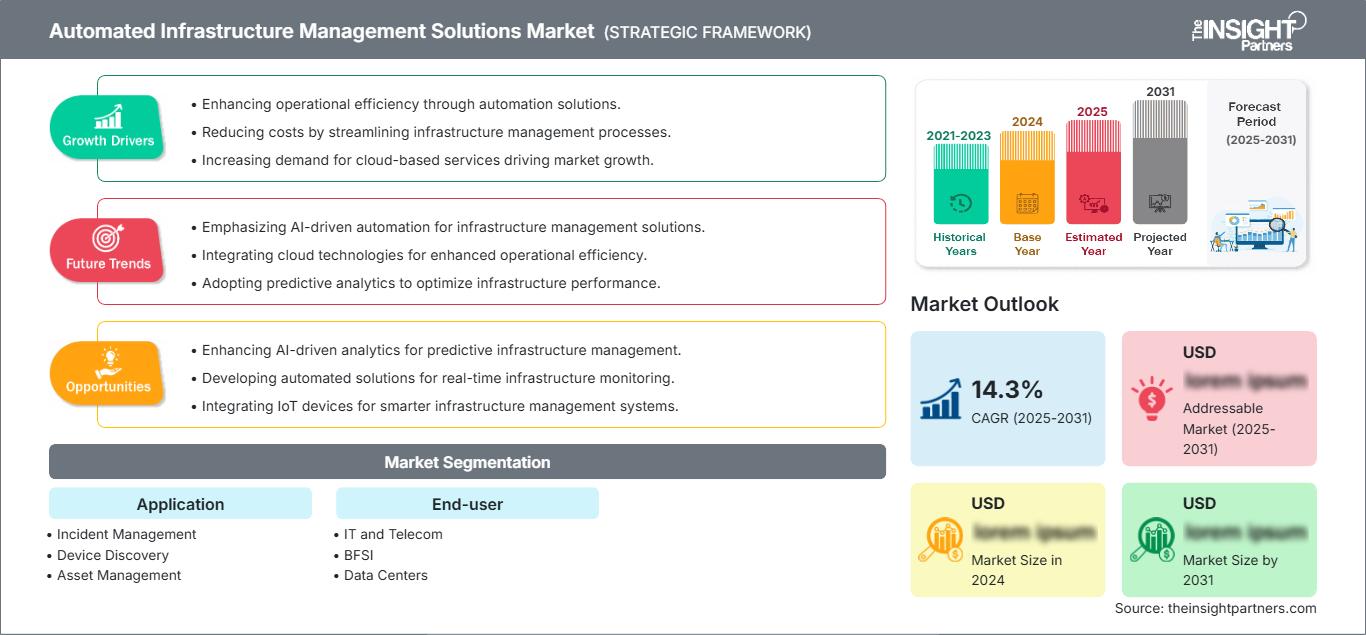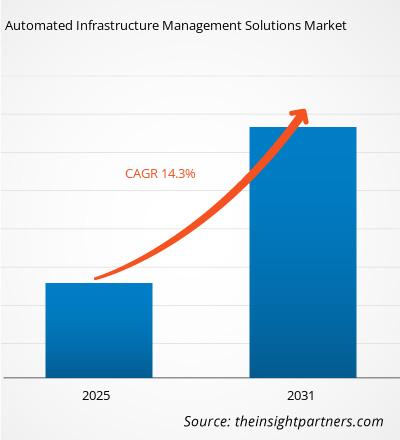自動化インフラストラクチャ管理ソリューション市場は、2023年から2031年にかけて14.3%のCAGRを記録すると予想されています。コンテナ化、マイクロサービス、そして新興のエッジコンピューティングは、引き続き市場の主要なトレンドとなるでしょう。
自動化インフラストラクチャ管理ソリューション市場分析
- これらは、ITインフラストラクチャの管理を容易にし、迅速化するために使用されるシステムとソフトウェアです。今日、インフラストラクチャの自動化への関心が高まっています。
- 自動化インフラストラクチャ管理(AIM)ソリューションは、ITの重要なテクノロジーであり、急成長を遂げており、今後数年間にわたって拡大し続ける可能性があります。この成長にはいくつかの理由があります。
- その中でも、データセンター施設への設備投資の増加は、AIMソリューションの可能性と必要な人的資本を高めています。この変革によりクラウドの導入が拡大し、市場の成長を大幅に後押ししています。
自動化インフラストラクチャ管理ソリューション市場の概要
- 自動運転車からがん検出アプリまで、あらゆる業界がデジタル変革を遂げており、これらのビジネスを支える IT インフラストラクチャの規模と複雑さは近年、前例のないレベルまで飛躍的に増大しています。
- ハイブリッドおよびマルチクラウド展開全体で運用され、エッジ、コア、クラウドにまたがる相互接続された IT インフラストラクチャを備えた、高性能でスケーラブル、かつ適応しやすい IT インフラストラクチャが必須条件になりつつあります。その結果、これらの IT 環境を効果的に管理できる自動化ソリューションへの需要が大きく高まっています。
- 組織は常に IT 運用に関連するコストを削減する方法を模索しており、自動化はその方法を提供し、運用の改善につながります。「北極星」となるソリューションへの要望が高まっています。数多くのDevOpsツールやベストプラクティスと統合し、インフラストラクチャ・アズ・コード(IaaS)ワークフローをサポートします。あらゆるものが「エッジ」化する中で、インフラストラクチャ管理をエッジに拡張するソリューションへの注目が高まっています。
要件に合わせてレポートをカスタマイズ
レポートの一部、国レベルの分析、Excelデータパックなどを含め、スタートアップ&大学向けに特別オファーや割引もご利用いただけます(無償)
自動化インフラ管理ソリューション市場: 戦略的洞察

- このレポートの主要な市場動向を入手してください。この無料サンプルには、市場動向から見積もりや予測に至るまでのデータ分析が含まれます。
レポートの一部、国レベルの分析、Excelデータパックなどを含め、スタートアップ&大学向けに特別オファーや割引もご利用いただけます(無償)
自動化インフラ管理ソリューション市場: 戦略的洞察

- このレポートの主要な市場動向を入手してください。この無料サンプルには、市場動向から見積もりや予測に至るまでのデータ分析が含まれます。
自動化インフラストラクチャ管理ソリューション市場の推進要因と機会
市場の活性化に向けたエンタープライズ デジタル トランスフォーメーションの加速
- 企業はデジタル化しなければ消滅します。エンタープライズ デジタル トランスフォーメーションの加速に関して、自動化インフラストラクチャ管理ソリューションの需要は重要な点で影響を受けます。まず、デジタル トランスフォーメーションは多くの場合、新しいテクノロジー、プラットフォーム、サービスの導入を意味します。これにより、複雑さ (多くのコンポーネントで構成されるエコシステムなど) と異質性 (異なる言語を話し、連携する必要がある多数のコンポーネントなど) が増大し、管理用の自動化ソリューションが必要になります。
- 次に、多くのデジタル イニシアティブでは、必要な IT リソースを迅速に拡張することがしばしば必要になります。自動化ソリューションを使用すれば、これらのリソース (アプリケーション、仮想マシン、ネットワーク、ストレージなど) を大規模に自動的にプロビジョニング、構成、管理できます。これは手動では困難です。第三に、多くのデジタル トランスフォーメーションの取り組みでは、アジャイル手法と継続的インテグレーション/継続的デプロイメント (CI/CD) プラクティスの導入が頻繁に行われます。
- 自動化されたインフラストラクチャ管理とは、これらのペースの速いループ型のアプローチを効率的かつ効果的に機能させることを意味します。そのため、企業のデジタル トランスフォーメーションの加速に伴う、要求が厳しくペースの速い性質により、インフラストラクチャ管理の自動化ソリューションに対する需要が高まっています。これは、あらゆる企業にとって、より複雑で要求の厳しい環境を全体的に効果的かつ効率的に管理する必要があるためです。つまり、生き残りを望む企業は、より複雑で動的かつ重要な IT 環境を管理できる必要があるということです。
DevOps 統合
- DevOps 統合 - DevOps ワークフローと統合し、継続的インテグレーション/継続的デプロイメント (CI/CD) パイプラインの一部としてインフラストラクチャのプロビジョニング、構成、管理を自動化できるツールを導入することは、自動化されたインフラストラクチャ管理ソリューション市場における重要なビジネス チャンスとなります。
- DevOps は、ソフトウェアの開発と配信のペースを加速させるニーズへの対応として登場しました。ソフトウェアリリースワークフローの自動化などのタスクを実行するために、自動化、継続的なフィードバック、機能サイロ間のコラボレーションを重視しています。DevOpsツールおよびワークフローと統合することで、ユーザーは「俊敏性」、「市場投入までの時間平均」、「リクエストの効率」を向上させることができます。
- DevOpsプロセスの加速を支援するもう1つの要素は、「インフラストラクチャをコードとして扱う」機能です。これにより、インフラストラクチャの変更に対するバージョン管理と自動テストが容易になります。強力なDevOps統合は、ソフトウェア配信の速度を向上させ、エラーを削減するのに役立ちます。したがって、この理念に沿った技術ソリューションを採用することで、今日の急速に変化するIT環境において、ソリューションの魅力が大幅に高まります。
自動化インフラストラクチャ管理ソリューション市場レポートのセグメンテーション分析
自動化インフラストラクチャ管理ソリューション市場分析の導出に貢献した主要なセグメントは、アプリケーションとエンドユーザーです。
- アプリケーションに基づいて、自動化インフラストラクチャ管理ソリューション市場は、インシデント管理、デバイス検出、資産管理に分類されます。 2023年には、インシデント管理セグメントが最大のシェアを占めました。
- エンドユーザーに基づいて、自動化されたインフラストラクチャ管理ソリューション市場は、ITおよび通信、BFSI、データセンター、エネルギーおよび公益事業、政府、製造業、その他に分類されます。ITおよび通信セグメントは、2023年に大きな市場シェアを占めました。
地域別の自動化されたインフラストラクチャ管理ソリューション市場シェア分析
- 自動化されたインフラストラクチャ管理市場レポートは、北米、ヨーロッパ、アジア太平洋(APAC)、中東およびアフリカ(MEA)、南米および中米の5つの主要な地理的地域の詳細な分析で構成されており、現在の市場規模と過去の市場規模、および2021年から2031年までの予測が含まれています。
- 各地域はさらにそれぞれの国に細分化されています。このレポートでは、18か国以上を対象に、地域レベルで市場に影響を与えている推進要因、傾向、機会など、自動化インフラ管理市場の動向を分析および予測しています。
- また、このレポートでは、これらの地域の自動化インフラ管理市場に影響を与える主要な要因の調査を含むPEST分析も取り上げています。
自動化インフラ管理ソリューション市場
予測期間を通じて自動化インフラ管理ソリューション市場に影響を与える地域的なトレンドと要因は、The Insight Partnersのアナリストによって詳細に説明されています。このセクションでは、自動化インフラ管理ソリューション市場のセグメントと地域についても、北米、ヨーロッパ、アジア太平洋、中東・アフリカ、中南米に分けて解説しています。
自動化インフラ管理ソリューション市場レポートの範囲
| レポート属性 | 詳細 |
|---|---|
| の市場規模 2024 | US$ XX million |
| 市場規模別 2031 | US$ XX Million |
| 世界的なCAGR (2025 - 2031) | 14.3% |
| 過去データ | 2021-2023 |
| 予測期間 | 2025-2031 |
| 対象セグメント |
By アプリケーション
|
| 対象地域と国 | 北米
|
| 市場リーダーと主要企業の概要 |
|
自動化インフラ管理ソリューション市場のプレーヤー密度:ビジネスダイナミクスへの影響を理解する
自動化インフラ管理ソリューション市場は、消費者の嗜好の変化、技術の進歩、製品メリットへの認知度の高まりといった要因によるエンドユーザー需要の高まりに牽引され、急速に成長しています。需要の増加に伴い、企業は提供内容の拡充、消費者ニーズへの対応のためのイノベーション、そして新たなトレンドの活用を進めており、これが市場の成長をさらに加速させています。

- 入手 自動化インフラ管理ソリューション市場 主要プレーヤーの概要
自動化インフラ管理ソリューション市場のニュースと最新動向
自動化インフラ管理ソリューション市場は、主要な企業出版物、協会データ、データベースなどの一次調査および二次調査を経て、定性および定量データを収集することで評価されます。自動化インフラ管理ソリューション市場における動向の一部を以下に示します。
- Broadcom Inc.は、Automic® AutomationソリューションがSoftware as a Service(SaaS)として提供されるようになったと発表しました。Automic SaaSは、市場をリードするAutomic Automationオンプレミスソリューションと同じ機能に加え、サービスとしてのメリットを提供します。高度なワークロード自動化およびワークフローオーケストレーション機能を備えたAutomic SaaSは、メインフレーム、分散型、ハイブリッドクラウド環境全体の自動化を統合および簡素化するとともに、通常インフラ管理に吸収されるリソースを解放し、より戦略的な自動化プロジェクトに集中できるようにします。(出典:Broadcom Inc.、プレスリリース、2024年5月)
- IBMは、ネットワークおよびITインフラ自動化製品の大手プロバイダーであるPliantを買収したと発表しました。 Pliantは、ネットワークおよびITインフラストラクチャのタスクを自動化し、これらの機能をアプリケーション層に抽象化するための重要な機能を追加します。これにより、アプリケーション(および開発者)は、アプリケーション自体内でインフラストラクチャのプロビジョニングと管理を簡素化し、最大限の制御が可能になります。これらの最適化には、従来のネットワークおよびITインフラストラクチャとパブリッククラウドの両方におけるインフラストラクチャリソースのプロビジョニングと管理、トラフィック管理、構成管理が含まれます。(出典:IBM、プレスリリース、2024年3月)
自動化インフラストラクチャ管理ソリューション市場レポートの対象範囲と成果物
「自動化インフラストラクチャ管理ソリューション市場規模と予測(2021~2031年)」このレポートでは、以下の分野を網羅した市場の詳細な分析を提供しています。
- 自動化されたインフラストラクチャ管理ソリューションの市場規模と、調査対象となるすべての主要市場セグメントの世界、地域、国レベルでの予測
- 自動化されたインフラストラクチャ管理ソリューションの市場動向、および推進要因、制約、主要な機会などの市場動向
- 詳細なPEST / Porterの5つの力とSWOT分析
- 主要な市場動向、世界および地域の枠組み、主要プレーヤー、規制、および最近の市場動向を網羅した自動化されたインフラストラクチャ管理ソリューション市場分析
- 自動化されたインフラストラクチャ管理ソリューション市場の市場集中、ヒートマップ分析、主要プレーヤー、および最近の動向を網羅した業界の状況と競争分析
- 詳細な企業プロファイル
- 過去2年間の分析、基準年、CAGRによる予測(7年間)
- PEST分析とSWOT分析
- 市場規模価値/数量 - 世界、地域、国
- 業界と競争環境
- Excel データセット
最新レポート
関連レポート
お客様の声
購入理由
- 情報に基づいた意思決定
- 市場動向の理解
- 競合分析
- 顧客インサイト
- 市場予測
- リスク軽減
- 戦略計画
- 投資の正当性
- 新興市場の特定
- マーケティング戦略の強化
- 業務効率の向上
- 規制動向への対応




















 無料サンプルを入手 - 自動化インフラ管理ソリューション市場
無料サンプルを入手 - 自動化インフラ管理ソリューション市場